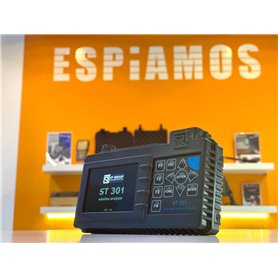1 product

Telephone Line Analyzer: Eavesdropping Detection and Protection
A telephone line analyzer is a device designed to detect and neutralize any type of interference or manipulation in wired communications. Its use is essential in security audits and protection against eavesdropping , ensuring that telephone conversations are not intercepted.
The operation of a wiretap detector is based on the analysis of anomalous signals within the communication line. These devices identify voltage fluctuations, deviations in electrical current, and the presence of unauthorized recording or transmitting equipment.
Among the key advantages of advanced telephone line analyzers are their ability to detect hidden microphones on landline phones, identify unauthorized line modifications, and analyze connection integrity in real time.
Main Uses of Telephone Line Analyzers
- Wiretap Protection: Identifies wiretaps and covertly connected recording devices.
- Corporate Security Audit: Used in offices to ensure the confidentiality of calls in offices and meeting rooms.
- Listening Device Detection: Locates hidden microphones, recorders, and wireless transmitters in landline telephones and communication systems.
- Telephone Network Inspection: Allows you to verify the quality and security of connections in critical infrastructure or in government environments.
Types and Key Features of Telephone Line Analyzers
Telephone security analyzers have evolved to offer advanced solutions for detecting threats within communication networks. Depending on the type of line and the level of protection required, there are different models with specific features. Below, we highlight the main types and their most relevant functions:
- Analog Telephone Line Analyzers: Designed to inspect conventional networks, detecting spy microphones, hidden recorders, and unauthorized diversions.
- Digital and VoIP Line Analyzers: Advanced devices that identify interceptions in modern telephone systems, such as Voice over IP (VoIP) networks.
- Anomalous Voltage Detectors: Models that analyze variations in line voltage and current to identify tampering or clandestine devices.
- Active Scan Mode Analyzers: Allow real-time testing to detect suspicious interference in calls or data connections.
- Wireless Signal Detectors: Devices that combine line tamper detection with the search for hidden transmitters that send audio signals remotely.
- Professional Models with Event Logging: Devices that store and analyze historical data to detect patterns of communication intervention.
Selecting the right telephone line analyzer depends on the type of network being inspected, the required sensitivity level, and the ability to analyze suspicious signals. These features ensure effective protection against any eavesdropping attempts.
Where to Buy a Telephone Line Analyzer?
At ESPIAMOS®, we offer a selection of telephone line analyzers designed with the latest technology to guarantee privacy in communications. We also offer exclusive benefits to ensure a reliable and secure purchase:
- Specialized Technical Advice: Our security team will help you choose the most suitable analyzer for your needs.
- Extended Warranty on All Products: We offer additional coverage to ensure the proper functioning and durability of the equipment.
- Fast and Discreet Shipping: All deliveries are made with complete confidentiality and without any identifying marks on the package.
- Secure Payments and Absolute Privacy: Billing is processed using the “HID” method to protect the buyer’s identity.
- Immediate Availability and Permanent Stock: We have a wide variety of models ready for immediate shipment.
Discover our collection of telephone line analyzers and protect the privacy of your communications with the best technology available.
Frequently Asked Questions about Telephone Line Analyzers
What exactly does a telephone line analyzer detect?
A telephone line analyzer can identify any disturbance in a wired communications network. It detects the presence of spy microphones, call diverters, hidden recorders, and unauthorized transmitters. It analyzes electrical signals and variations in the line, allowing it to find clandestinely connected devices, even if they are inactive. It also helps verify the integrity of wiring and connections. It is an essential tool for checking whether a line has been manipulated for espionage purposes.
Can it work on modern lines like VoIP or digital?
Yes, there are specific models that can inspect both analog and digital lines and VoIP systems. In the latter case, the analyzer examines data packets, interference, flow deviations, and residual signals that could indicate intervention. Some advanced devices also include functions to detect parallel connections or tampering in switchboards. It is important to choose a model compatible with the type of network you want to protect to ensure a reliable and comprehensive analysis.
When is it advisable to use an analyzer of this type?
Its use is recommended in any situation where confidential information is handled over the phone. This includes professional offices, corporations, law firms, newsrooms, and government institutions. It is also useful if you suspect a line has been tapped, especially if there are changes in call quality, unusual sounds, or abnormal battery consumption on cordless landlines. Conducting periodic audits helps prevent information leaks.
What advantages does it have over a traditional microphone detector?
Unlike radio frequency detectors, which require the spy device to be transmitting a signal, the telephone line analyzer can detect threats even if the microphone is idle or connected by a cable. It analyzes specific electrical parameters of the line, identifying tampering with great precision. Additionally, some models record historical events and allow for more detailed analysis, making them ideal tools for technical and legal inspections in sensitive environments.
Is it difficult to interpret the results you offer?
Most current models are designed with intuitive interfaces, easy-to-understand visual readouts, and automated scanning functions. Many include audible alerts or LED indicators that guide the user through the inspection. For more technical models, ESPIAMOS® offers personalized advice that facilitates the correct interpretation of results. This allows both private and professional users to use the device effectively, without the need for specialized training.






 WhatsApp
WhatsApp Telegram
Telegram




